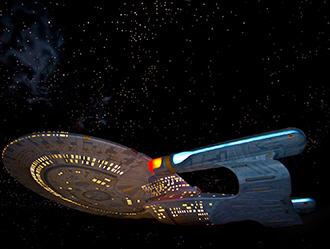Looking forward to the 24th century: cardiac arrest remains a deadly problem – but for different reasons from today

Emergency medicine in the make-believe 24th century
Right from the start, the scientists were involved in the production of the Star Trek series. The famous researcher Stephen Hawking, a self-confessed Star Trek fan, once wrote in a preface that the series “expands the human imagination”. Many of the technical devices that occur very early on in the series have become reality. Even in the pilot film in 1966, the crew was given a message on a sheet of paper that was emitted from a machine. In those days, the fax machine hadn't even been invented. It wasn't until 1979 that the first fax machines were connected to the telephone network.
Captain Kirk's “communicator” from 1966 can be regarded as the fore-runner to the modern-day mobile phone. Some manufacturers later declared that they had been inspired by Star Trek. The same goes for hands-free earpieces, flat screens, video phones or a type of laptop. All of these had been used in the Star Trek series long before they were used in the real world.
Emergency medicine in the make-believe 24th century
Scientists at the MedUni Vienna now used this vision of the future to take a look at emergency medicine in the make-believe 24th century. The result: even in the world of Star Trek, a cardiac arrest is associated with high mortality – albeit less due to general medical reasons than today. “The treatment of cardiac arrests is a very highly-researched field of modern medicine. Unfortunately, survival rates after an event such as this have continued to stagnate at a low level for many years,” explains study leader David Hörburger. “The aim of the study was to analyse its epidemiology and treatment in the way it is fictitiously portrayed in the 24th century in the world of Star Trek in order to find inspiration for the present day.”
526 episodes of the TV series “Star Trek – The Next Generation”, “Star Trek: Deep Space Nine” and “Star Trek: Voyager” were studied to determine the occurrence of cardiac arrests. A total of 96 cardiac arrests were documented and analysed.
In the 24th century, people “live” more healthily
A cardiac arrest is therefore associated with high mortality in the 24th century too (around 90 per cent). However, an analysis of how they are portrayed in the Star Trek series illustrates a significant shift in the cause from general medical to traumatological, i.e. death caused by severe physical injury, injury caused by “energy weapons” and poisoning, rather than by heart attacks or cardiac arrhythmias, which are the most common causes of present-day cardiac arrests. Says Hörburger: “This invites the conclusion that people in the future will be living much more healthily and will have better preventative medicine than we do now.”
Another interesting result of this analytical glimpse of a make-believe future is that, today, people who suffer a cardiac arrest in hospital have the best chances of survival, followed by patients who have a cardiac arrest in the street. The poorest outlook is reserved for people who have a cardiac arrest at home. In the Star Trek future presented in this study, this situation is different – and can be explained by the technology of “teleportation”, i.e. the lightning-fast transport of a human through the transfer of matter from one location to another. Hand-held medical scanners (“tricorders”) were also used frequently in the programmes and helped to treat patients.
Full bibliographic information
Resuscitation
„Where no guideline has gone before: Restrospective analysis of resuscitation in the 24th century.“ D. Hörburger, J. Haslinger, H. Bickel, N. Graf, A. Schober, C. Testori, C. Weiser, F. Sterz, M. Haugk. http://dx.doi.org/10.1016/j.resuscitation.2014.10.008.
Media Contact
All latest news from the category: Health and Medicine
This subject area encompasses research and studies in the field of human medicine.
Among the wide-ranging list of topics covered here are anesthesiology, anatomy, surgery, human genetics, hygiene and environmental medicine, internal medicine, neurology, pharmacology, physiology, urology and dental medicine.
Newest articles

High-energy-density aqueous battery based on halogen multi-electron transfer
Traditional non-aqueous lithium-ion batteries have a high energy density, but their safety is compromised due to the flammable organic electrolytes they utilize. Aqueous batteries use water as the solvent for…

First-ever combined heart pump and pig kidney transplant
…gives new hope to patient with terminal illness. Surgeons at NYU Langone Health performed the first-ever combined mechanical heart pump and gene-edited pig kidney transplant surgery in a 54-year-old woman…

Biophysics: Testing how well biomarkers work
LMU researchers have developed a method to determine how reliably target proteins can be labeled using super-resolution fluorescence microscopy. Modern microscopy techniques make it possible to examine the inner workings…





















